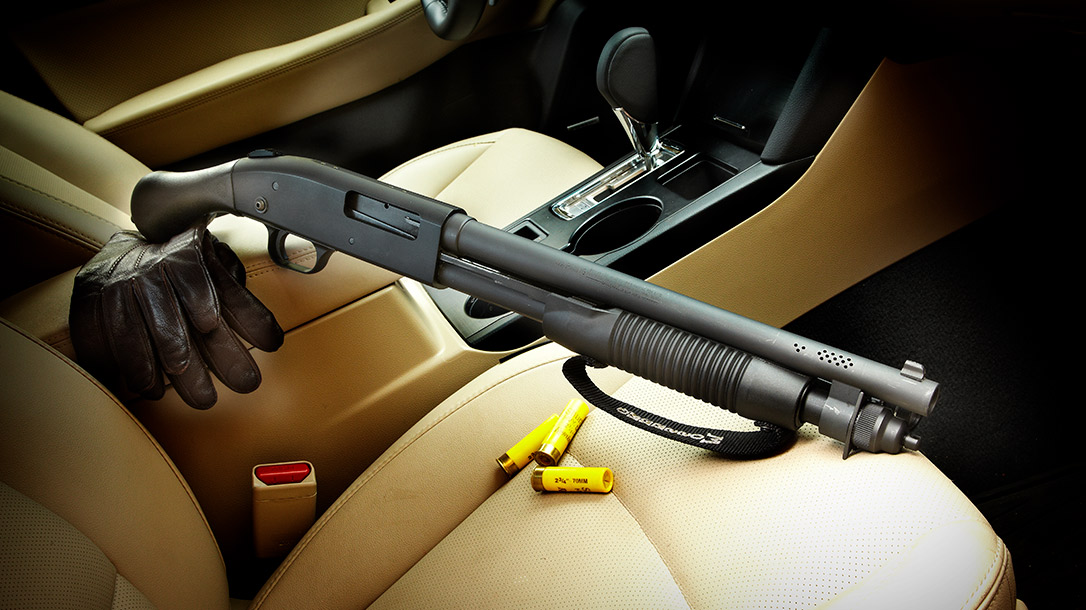A criminal assault can ruin your entire day. Likewise, awaking from sleep to the noises of a break-in will ruin your sleep and change how you see your home—possibly forever. That’s why shotguns, like the Mossberg 590 Shockwave 20-Gauge make great home defenders.
The Mossberg 590 Shockwave 20-Gauge
Such personal attacks occur primarily in and around dwellings and vehicles. To defend against them, you need high-quality training and adequate preparation. If you believe that self-defense can be effectively accomplished with butcher knives, baseball bats and boiling water, too much of your “training” has consisted of video games or Hollywood movies.
Pre-Planning
Some people give insufficient thought to potentially violent interactions that may occur. Others just stop at thinking. Those just diddling around with the notion of self-defense might purchase a firearm, and at some point tell the family they have one. But serious self-defense practitioners typically allot plenty of time to carefully examining potential problems. Smart people also include at least a modicum of pre-planning and training in their efforts.
Advertisement — Continue Reading Below
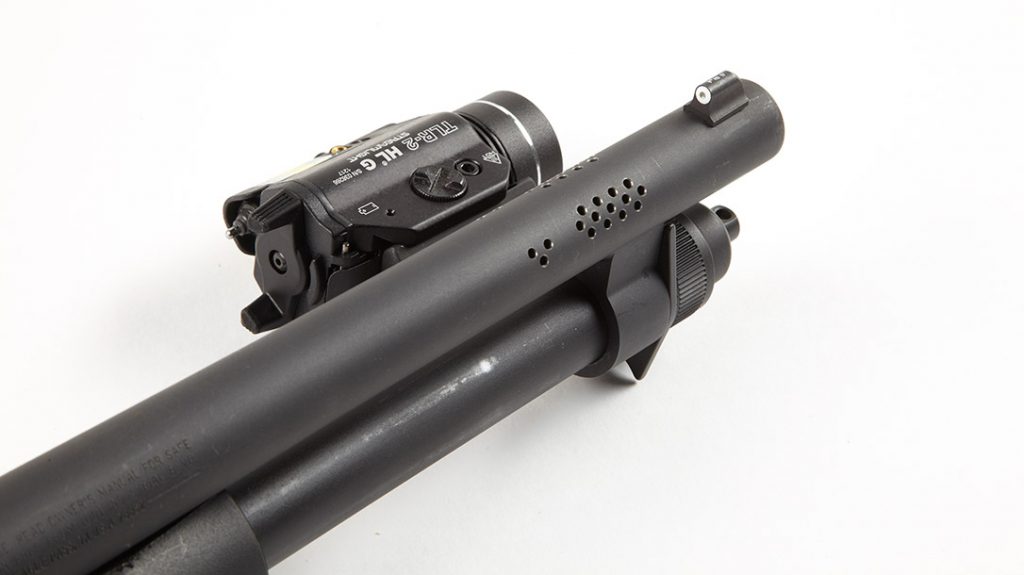
One of your first tasks is to establish defensible safe rooms in your home. In the event of an attack you can gather your spouse, children and weapons into these rooms, dial 911 and wait for the police to arrive. Equipment available in your safe room should include: cell phones and chargers, landlines, flashlights, batteries and firearms with extra ammunition.
Next, you should formulate a plan for everyone’s arrival at the designated safe room, and for the location and allocation of any previously staged firearms in the safe room. Everyone should remain inside the safe room unless it’s absolutely necessary to leave, or when the danger is over. Outside the safe room, the danger level increases. This is where training pays off, and where compact firearms will shine.
Advertisement — Continue Reading Below
Pre-planning should determine—and everyone in the household should be informed of—all evacuation routes, as well as safe rooms and other desirable primary options. There may be several routes of ingress and egress in your home, and it will be helpful to explain them all to anyone who may visit your home and its potential conflict areas, or anyone who might need an escort to safe rooms.
Establish a Safe Room
Establishing a safe room allows you to identify fire lanes that are free of family members, with backstops such as refrigerators, cabinets and fireplaces. When you’re maneuvering in a house, everything is downrange from your firearm muzzles. Every room should also have 360-degree fire lanes.
Home-defense pre-planning also applies to hotel rooms where you might stay when you’re traveling. Hotel rooms usually have separate bathrooms—these are adaptable as impromptu gathering spots. A substantial wedge kicked under the door, or a doorstop wedged under your room’s doorknob will probably be the only passive fortifications that are available.
Advertisement — Continue Reading Below
A smart man once said: “During a gunfight, it’s too late to learn how to fight.” Get yourself qualified beforehand, by training for home and vehicle defense, at the very least.
Safe Room Arms
Weapons for safe rooms vary greatly, depending on people’s individual opinions and situations. Handguns are popular recommendations for home-defense scenarios, but offer relatively poor stopping power. Handguns also require skills that many users won’t achieve. Even targets as close as the end of a 20-foot hallway may still be safe from the inexperienced shooter.
The AR-15 family of rifles is another favorite, but these involve interior, and occasionally exterior, wall overpenetration. Even with their stocks fully collapsed, carbines still exceed the new non-NFA shotguns’ length by about 7 inches. Length is important if defenders leave the safe room. Longer firearms increase the potential for entanglement, telegraph position to the bad guys and are easier to take from inexperienced users.
Advertisement — Continue Reading Below
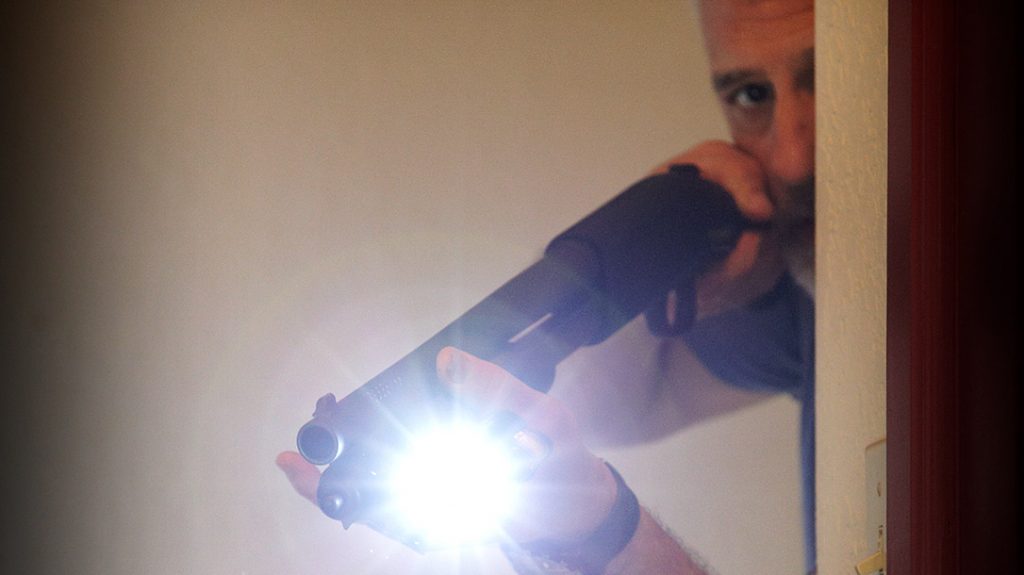
I chose Mossberg’s non-NFA, 20-gauge 590 Shockwave shotgun over other possible weapons. The standard 590 is the basis for the shotgun serving U.S. military forces since 1975.
Shotguns fire multiple pellets downrange with each shot, creating multiple wounds in your adversary. Even with birdshot, penetration of interior walls in a home might be possible, and larger pellets (especially buckshot) increase the overpenetration potential. These are excellent reasons why all pellets should remaining inside the attackers.
Advertisement — Continue Reading Below
Few pellets of any size will penetrate brick or high-quality rock walls. (Studs used in drywall construction can also deflect or stop projectiles.) Of course, not every home features a brick or stone exterior. And even homes that do also have windows and doors, which are potential escape routes for any errant bullets.
No matter where you are when an attack begins—on the street, within a dwelling or in an automobile—when you fling bullets indiscriminately into the air, each one wears your name. If they run wild, the liability is yours.
Shockwave Smoothbore
Mossberg’s 590 Shockwave in 20-gauge includes a heavy-walled barrel with a cylinder bore choke and a front bead sight. Barrel length is just 14.37 inches. The gun weighs 4.9 pounds. Polymer Shockwave Raptor grips, in lieu of traditional stocks, yield a petite package measuring 26.37 inches long. The Raptor’s length and design make this shotgun very maneuverable in tight spots and reduce felt recoil.
Advertisement — Continue Reading Below
The Mossberg Shockwave holds an impressive 5+1 rounds (2¾-inch shells) in its one-piece magazine tube. The forend is a corncob style with a strap to help keep your hand away from the muzzle.
More compact than a pistol-grip shotgun, the Shockwave won’t easily succumb to tight quarters problems. Some people are put off by a 12-gauge blast and the accompanying recoil, or unable to handle it because of age or physical condition. A Shockwave firing 20-gauge brings with it a lighter recoil.
Birdshot or Buckshot?
Some people believe that a Shockwave loaded with birdshot, with a pattern spanning a hallway at 7 to 10 yards, will be adequate despite pattern gaps. However, birdshot of any kind has varying difficulties in delivering killing blows, if it penetrates clothing and flesh. Tight groups of unhampered pellets could probably penetrate two to four sheets of drywall, but would also lose potency rapidly as the distance increases.
Advertisement — Continue Reading Below
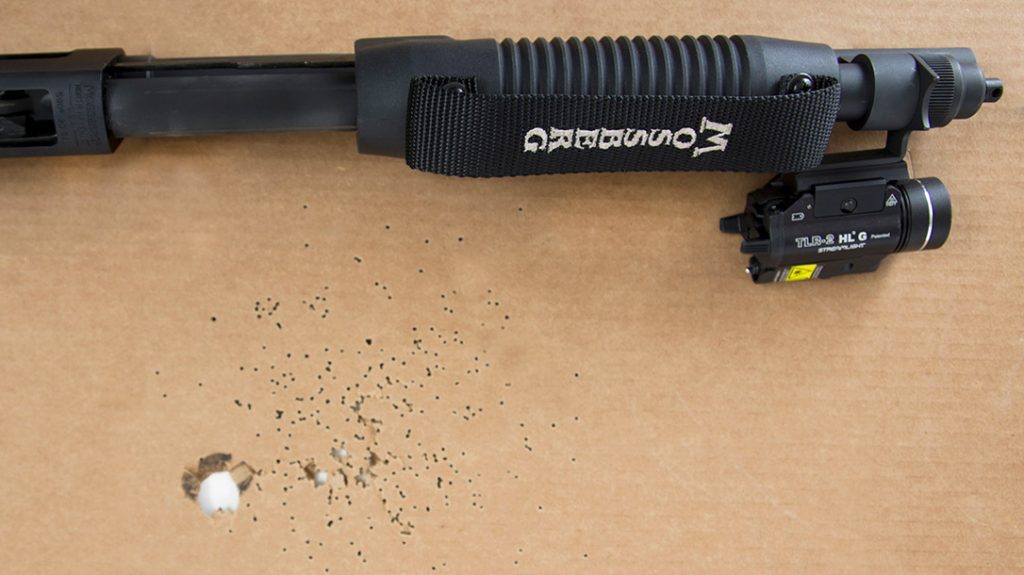
I tested the patterns of a variety of shotshells at 10 and 7 yards. The Remington Express XLR No. 5 shot produces patterns about 9 inches across, which is certainly not hall-filling. XLR buckshot was not readily available in my area, but both Remington and Winchester No. 3 buckshot delivered patterns around 6.5 inches.
For defensive work, I want a fairly tight, even pattern. Tight patterns mean fewer pellets missing attackers and running wild. This also allows for more precise shot placement. If the battle goes outside, a tight pattern adds more distance to the Shockwave’s effectiveness.
Advertisement — Continue Reading Below
Add-Ons
The 20-gauge Shockwave works well, even without accessories. Still, I like the TLR-1 HL or TLR-2 HL G (forward light or light/laser), GG&G’s Shockwave 20-gauge flashlight mount, XS Sights epoxy-attachment tritium front sight, Blue Force Gear Single Point Sling, Vang Comp Systems oversized safety and GG&G’s QD Rear Sling Attachment.
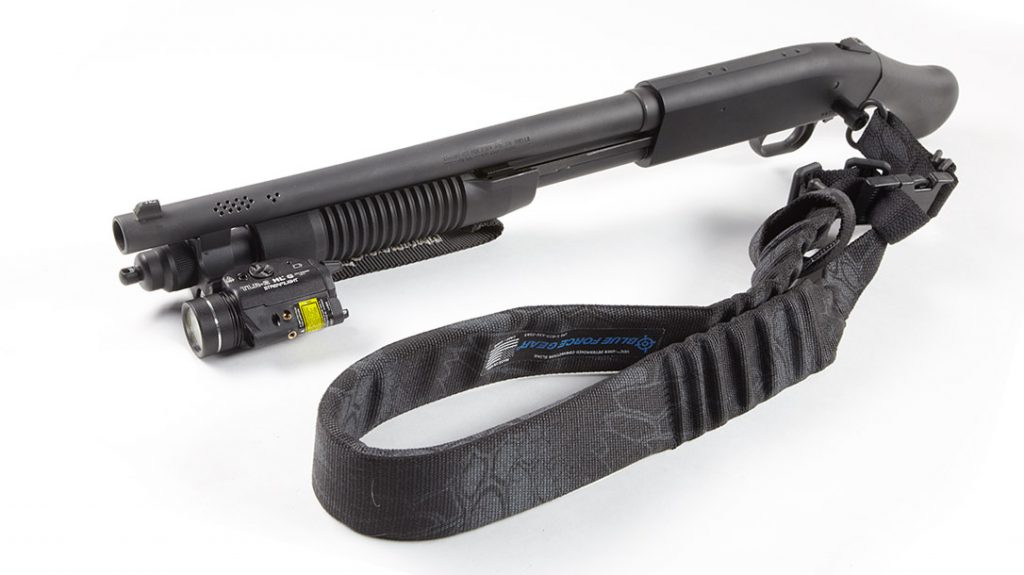
Instead of the attachment point included on the Shockwave grip, I chose GG&G’s QD sling receiver attachment. I pushed the single-point sling to rigid full extension, making it similar to a real stock. Because of my short Tyrannosaurus arms, I have to cinch up the sling when it’s attached to the QD receiver mount. I’m not sure the sling could be shortened enough to work using the non-QD point on the birdshead grip.
I added Vang Comp’s System, with backboring and porting, for tighter, more even patterns and improved muzzle control. In my testing of the gun, birdshot patterns ran about 6.5 inches, while the Remington and Winchester No. 3 buckshot patterns dropped to around 2.5 inches. Perfect!
My Car, My Castle
Vehicles are castle-like. If armed trouble crops up, it will probably be outside, shooting inward. The best option is driving away, although a GMC Sierra, at 5,000 pounds, can reverse many attacks.
The two most common vehicular attack techniques include forcing assailants off the road to make them stationary, easy targets, or charging stationary automobiles hindered by traffic lights, parked or creeping along in heavy traffic.
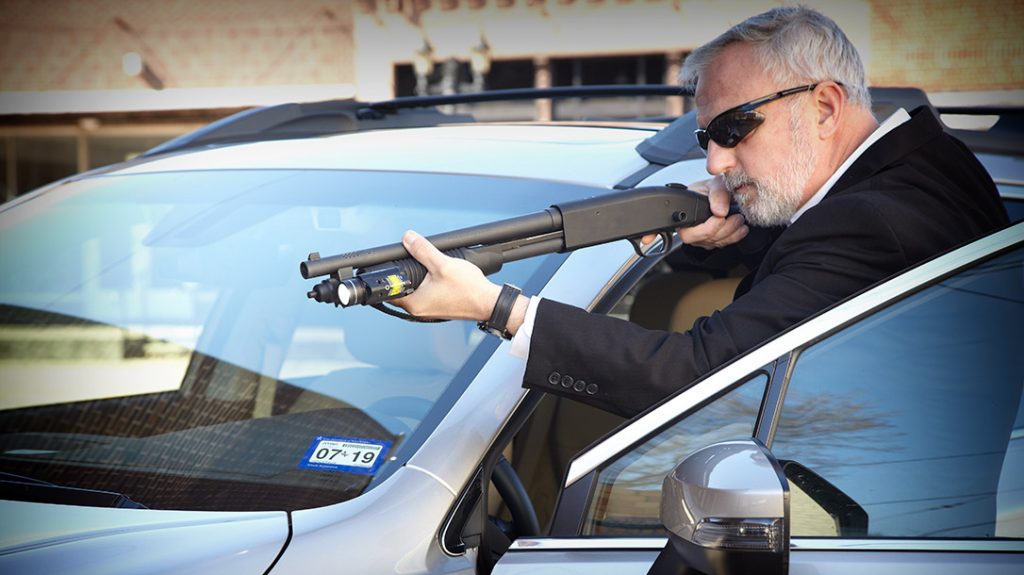
Today’s vehicles are made primarily of aluminum and plastic, engendering no feeling of comfort when bullets are involved. Reasonable protection while you’re returning fire from the sides of a vehicle is behind the wheels or behind the engine compartment. Avoid the temptation to shoot over the hood, the trunk or the roof. And keep an eye open for an enemy flanking your position. Attackers and robbers need to get close. They can’t rob someone or steal their vehicle or wallet from 40 feet away.
If danger presents itself at the front or rear of a vehicle, the engine compartment will still provide some protection. But tires don’t help much. Protection from the windshield or the rear window is tenuous. Wind shields are not amazingly effective against bullets but are still better than my skin. As in a dwelling, pre-planning is vital for self-defense in a vehicle.
Defenders might have several firearms in play. Unlike in a home safe room with essentially stationary positions, people and firearms will be in continuous motion. Muzzle control and firearm safety must be paramount.
Stay Safe
What should you take away from this? The best defense is quickly and safely exiting any area of danger. With dry practice runs and pre-planning, your odds of successful dwelling and vehicular defense improve.
Get training, pre-plan responses to scenarios, store items in safe rooms or vehicles, establish assignments for everyone, practice maneuvering in dwellings and in and around vehicles. Determine directions your bullets may fly safely. Finally, obtain house and vehicular defense training, using your defensive weapons. For more information visit Mossberg.com.
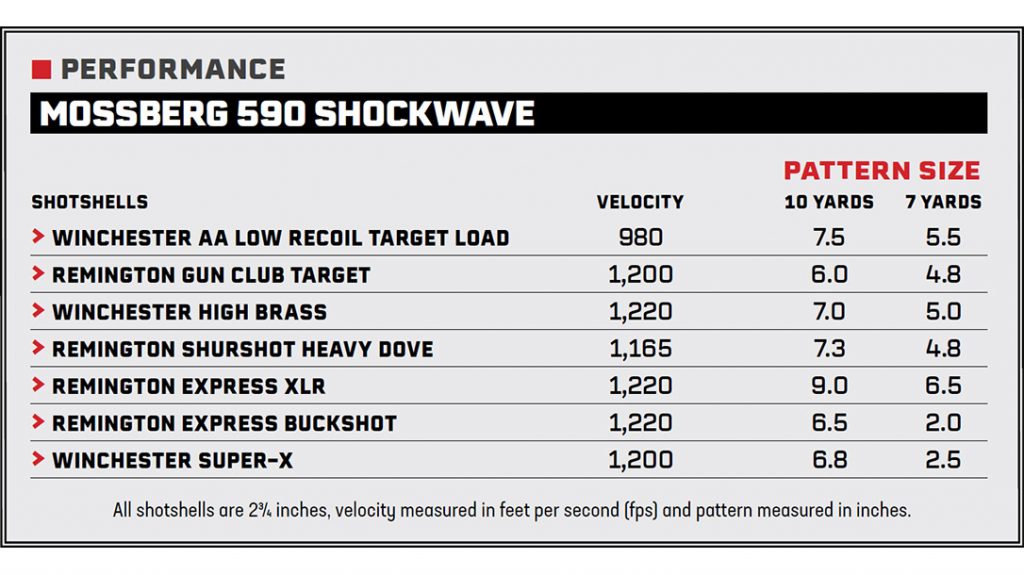
Mossberg 590 Shockwave 20-Gauge Specs
Gauge: 20
Barrel: 14.38 inches
OA Length: 26.37 inches
Weight: 4.95 pounds (empty)
Grips: Raptor
Sights: Bead front
Action: Pump
Finish: Matte blued
Capacity: 5+1
MSRP: $500
This article was originally published in the Personal Defense World Aug/Sept 2021 issue. Subscription is available in print and digital editions at OutdoorGroupStore.com. Or call 1-800-284-5668, or email subscriptions@athlonmediagroup.com.
